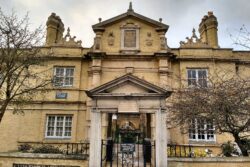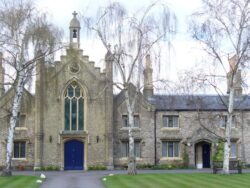- You can read more about Richmond’s historic almshouses, and the lives of their residents, in our book Poverty and Philanthropy in Victorian Richmond
by Simon Fowler
Richmond upon Thames has many almshouses, although they are well hidden. Unless you looked you would probably never recognise them. The most visible are not actually almshouses any longer. They were originally the Bootmakers’ Almshouses, an attractive set of mid-Victorian cottages located next to Mortlake Station, which were built in the 1850s to house “aged and decayed” bootmakers and their families. Unfortunately, they were sold off in 1930 and have long been private houses.
Almshouses have provided sheltered accommodation for elderly people since medieval times. Originally, they would have housed poor but respectable and, above all, god-fearing local residents. None of our local almshouses are as venerable. Queen Elizabeth’s Almshouses were founded in 1600. The original buildings were badly damaged during the Second World War and new premises were built in The Vineyard on Richmond Hill in 1955.
Also in The Vineyard is Bishop Duppa’s Almshouses, which were founded in 1661 by Bishop Duppa of Winchester, who had been in exile in Richmond during the Commonwealth. He provides the reason why are spelt out on the entrance: “I will pay my vows which I made to God in my troubled times.” A Latin inscription next to it reads in translation: “In the memory of the most fortunate return of Charles II to his people, Bishop Duppa of Winchester erected this to the honour of God and relief of the poor.”
Houblon’s Almshouses, which are close to the Red Cow pub on Sheen Road, were founded by two sisters Rebecca and Susannah Houblon in 1757 for nine poor women. As was not uncommon, the sisters laid down strict and almost impossible-to-obey rules governing the behaviour and religious life of the residents.
The most attractive of Richmond’s almshouses are probably Hickey’s Almshouses which are also on the Sheen Road. Peering through the gates it rather looks like a quad from a small Oxbridge college. Hickey’s is also the largest, with some fifty residents. A London merchant, William Hickey, died in 1728 bequeathing his estate to support local charities. The property increased so much in value that the Trustees used funds in 1834 to build almshouses, lodges for the porter and nurse, and a chapel. The chapel is occasionally open to the public.
Almost all of the borough’s almshouses are now run by Richmond Charities. Remarkably, new ones are still being opened. In 2019 the Charities took over Manning Place, off Queen’s Road in Richmond, and in 2020 bought Wright’s Almshouses in Heath Road, Twickenham. It consists of nine one-bedroom level-access almshouses, a guest room and a communal room. The facilities are a far cry from the cramped, dank conditions faced by many of the original residents of Richmond’s almshouses.Hickey’s Almshouses on Sheen Road.
This article was originally published in Twickenham and Richmond Tribune on 7 May 2021.

